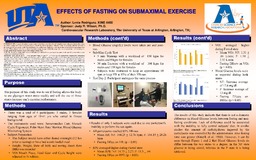| dc.contributor.author | Rodriguez, Lenia | |
| dc.date.accessioned | 2017-07-11T20:28:17Z | |
| dc.date.available | 2017-07-11T20:28:17Z | |
| dc.date.issued | 2016 | |
| dc.identifier.uri | http://hdl.handle.net/10106/26872 | |
| dc.description | KINE 4400 | en_US |
| dc.description.abstract | INTRODUCTION: Glucose is the primary energy source for the human body. It is obtained through eating carbohydrates among other things. Its chemical energy contributes to the generation of ATP during aerobic respiration. Glucose is stored in the body’s muscles and liver as glycogen where it can then be readily converted back to its original form. Studies have now shown there to be benefits from fasting before exercise. When eating carbs before a workout it promotes energy storage, inhibits the sympathetic nervous system and therefore reduces fat burning. In the fasting condition process such as energy storage cease.
PURPOSE: The purpose of this study was to see if fasting allows the body to use glycogen stores more readily and will the use of those stores increase one’s exercise performance.
METHODS: Three men (M;age22+4.5yrs) and three women (W;age27.7+8.7yrs) of the UTA student body, volunteered to participate in this study. Each subject had their height and weight recorded. All subjects performed a steady state 30 minute submaximal cycle test on two separate occasions. There were two conditions; Non-fasted (NF) in which subjects were able to have a carb loaded breakfast and fasted (F) in which subjects refrained from any meals 12 hrs prior to testing. During each test heart rate (HR) and rate of perceived exertions (RPE) were recorded while volume of oxygen consumption (VO2) was measured by the sensor medics cart. Blood glucose (BlGlu) levels were recorded pre and post-test.
RESULTS: All subjects reached 85%of their HRmax (NF:164.25+12.78bpm; F:164.15+20.28bpm) there was no significant difference between the conditions (p>0.05). The remaining values had similar outcomes. RPE (NF:14.75+2.27;F:15.3+.84); VO2 (NF:1.31+.86L/min;F:1.54+2.32L/min) both having values with no significant difference (p>0.05). BlGlu levels resulted as expected, there was an increase average of about 13mg/dL during fasted state. For non-fasted there was a decrease average of about17.6mg/dL. However, there was not a significant difference between the conditions (p>0.05).
CONCLUSION: The results of this study indicate that there is not a dramatic difference in Blood Glucose levels between fasting and non-fasting conditions. Lack of difference could be associated with the in ability to fully control subjects’ diet. | en_US |
| dc.description.sponsorship | Wilson, Judy R. | en_US |
| dc.language.iso | en_US | en_US |
| dc.subject | Fasting | en_US |
| dc.subject | Glucose | en_US |
| dc.subject | Glycogen | en_US |
| dc.subject | Submaximal exercise | en_US |
| dc.title | EFFECTS OF FASTING ON SUBMAXIMAL EXERCISE | en_US |
| dc.type | Presentation | en_US |
| dc.publisher.department | Department of Kinesiology, The University of Texas at Arlington | en_US |
| dc.publisher.department | Cardiovascular Research Laboratory, The University of Texas at Arlington | en_US |
| dc.publisher.department | Exercise Science Research Laboratories, The University of Texas at Arlington | en_US |

